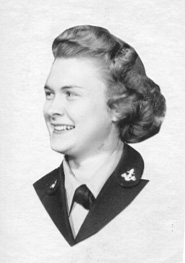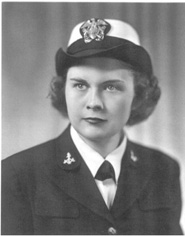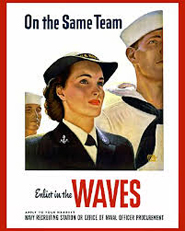Roberta Stock was born 4 February 1918, in Sioux City to John and Mabel (Waters) Stock. She attended Hunt, North Junior, and Central High School, and Morningside College and Iowa State.
Roberta writes, “In March of 1940, I graduated from Iowa State College with a B.S. degree in Home Economics and Applied Art and immediately left for Chicago and a job hunting career. Jobs were not abundant but I finally found employment with Sears and Roebuck Co. as a salesperson in the yard goods dept.
“Two months later, I left this company for a better paying position as a proof-reader with U.S. Gypsum Co. While there, I applied for the position of ‘Home Lighting Advisor’ with the Public Service Co. of Northern Illinois and accepted that position in late summer. Sor from 1940 to 1942, I served in that capacity and traveled to the communities of Joliet, Pontiac, Streator, Lacon and Blue Island, Illinois. In the summer of 1942, I was in the Blue Island office of this company where my additional duties included teaching classes in nutrition (in cooperation with the Red Cross agenda) to school groups and women’s clubs. This was a public relations situation and served as an additional public service the company sponsored. In as much as World
War 2 was engulfing our country, our company services were changing and I felt the time had come to be more involved in the war effort. The WACS were seeking volunteers and when I told my employers I was interested in that area of service, they advised me to wait. When the WAVES were beginning to recruit, I decided this was the time to leave civilian life and volunteer my services to the Navy. I applied, passed the tests in Chicago, was accepted into the Waves and reported to training in the first class for officer training in October 1942.
To become a WAVE officer at that time, a woman must have had at least two years of college, be between 20 and 50 years of age and pass another written and physical examination. WAVES had separate training centers for the officer candidates in Communication. I was sent to Smith College at Northampton, Mass. Other officer candidates were in training at Mt. Holyoke College at South Hadley, Mass. We were enlisted as ‘apprentice seamen’ and after completing a month of indoctrination we were then reserve midshipmen in the Women’s Reserve Midshipmen School. 44 of us from the Chicago area were sworn in and reported to Smith College, 1 October 1942. Training there meant drills in marching! We marched to ‘mess’ (meals in a cafeteria served on a metal tray) three times a day. We marched three miles a day - to assemblies, to classes and to meals. Our Naval clothing included a smart looking Navy blue $25.00 uniform plus hat plus raincoat plus overcoat. An officer WAVE could have (for $140.00) two jackets and two skirts which meant two suits; two Navy blue rayon blouses, three Reserve blue (light blue) cotton blouses, three white rayon blouses, one dress hat with three interchangeable crown covers and a havelock for rain use. Also required were black ties, blue ties, white gloves and black tie oxfords. We had to pass another physical exam, received two tetanus shots, three typhoid shots and one for smallpox. There were two battalions and I was in the Hotel Northampton battalion that consisted of three companies.
Each company consisted of three platoons totaling 150 trainees. I served as Commander of Company 1. My duties included ‘ mustering for meal times’, making announcements, leading drills and communicating with other Company and Battalion meetings and officers. My commission as Ensign was dated 31 December 1942 and my orders read to ‘proceed to the Communication Office at NYWASH (Navy Yard at Washington, D.C.)
The WAVES were to release 10,000 Navy men for active duty so after those months of intensive training and classes in coding and decoding messages, our group had those orders. Since the largest number of requests in late 1942 were for women trained in general communications, some of us
reported to the Navy Yard in Washington, D.C. and a larger number to the Navy Dept. in other parts of the U.S. 900 of us were sent to various ports and areas to release the men there.
In the Communication Watch office, we worked on shifts - 8 A.M. to 4 P.M.--4 P.M. to midnight--midnight to 8 A.M. In the office where I was stationed, we officers would receive from the yeoman any messages that they had taken from the ‘wire’ in code. We would decode them, send them to the department head, and when we received a reply to put back in code, we would encode them and give these messages to the yeoman to send out to the proper area. Many were reports of shipments of munitions, ordinance parts and some were weather reports. Messages classified as SECRET or CONFIDENTIAL or PRIORITY were handled by officers only for encoding or decoding.
In September of 1944, I requested change of duty from Communications in Washington, D.C. to the Bureau of Ordinance in the Ford Instrument Co. on Long Island where a fellow WAVE watch officer had been transferred. The hours were much better and I hoped to see a different aspect of the Navy as well as a new area - New York City. 16 November 1944, I received my transfer to that company and had an entirely different job there of checking Civil Service employees (under the Navy Dept.) who worked on Gunsights. Previously, I had received a promotion to Lt. (Jr. grade) in March of 1944. On or about 15 January 1945, I received a transfer to the Naval Ordinance at Sperry Gyroscope Co., Inc. to serve in Personnel Administration as Naval Inspector of Civil Service Employees’ records in BuOrd. On 16 August 1945, I was promoted to Lt. (Sr. Grade). I was the only WAVE assigned there to this company and served there until after V-J Day. My resignation was accepted in November of 1945 and my official honorable discharge date was 22 December 1945 and I returned to my home in Sioux City (2307 Jackson Street).
I enjoyed every aspect of my Navy ‘career’ -- the training in Massachusetts and meeting so many women and men of the Navy - all with the same purpose of helping in some way in the war effort. All the offices I worked in were congenial places with no dangerous experiences and interesting personnel. It was a fascinating world in Washington, D.C. and New York City at that time. I never suffered in any way and I hope I helped my country in some way in those war years.
I married 17 August 1946, in Sioux City, to Don Pendleton. We have resided here since then. Don served in the F.B.I. on the west coast from 1942 to 1945.
Submitted by Roberta Stock Pendleton.
![]()


